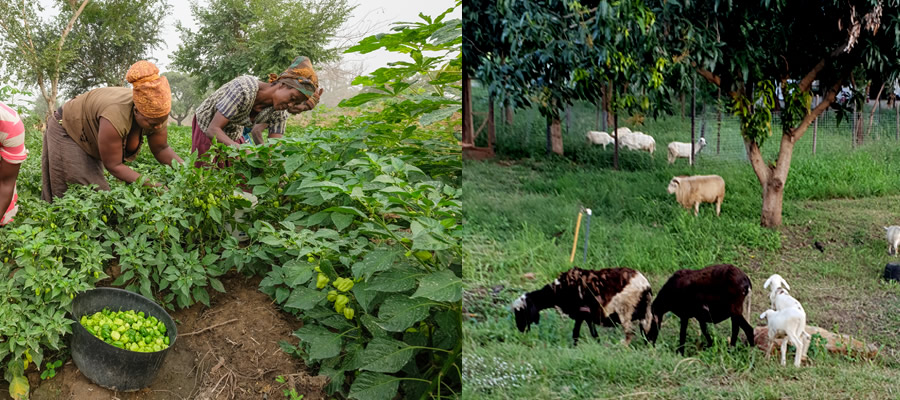

Latest census figures from Ghana Statistical Service (2000) indicate that there are 96,809 persons within the district. Out of this, 46,550 (48.2%) are males and 50,259(51.8%) are females. Based on this figure and the current district growth rate of 2.1% per annum, it is estimated that the population of the district presently stands at 107,532. This annual growth rate (2.1%) has not changed over the last three censual periods (1970, 1984 and 2000). With relative stability in fertility rates and the appreciable reduction in death rates nationwide, the general expectation was that the district would record an increase in the population given the availability of land.
This did not happen due to the inadequate number of secondary and tertiary activities/facilities and the stagnation in agriculture production and productivity. These are pull factors that attract population into regions. The district’s proximity to Accra, the national capital and Tema, the harbour and industrial city helps in elasticizing the pull of population from the district.
Since the last development plan, a new feature that has come to bear on the district’s population is the invasion of estate developers into the district. Availability of cheap agricultural lands is forcing these developers into converting the district into dormitory towns for workers in Accra. This is going to have a profound impact on the population of the district sooner or later
.Again some of the major interventions of the agriculture led Millennium Challenge Account (Ghana) programme are the construction of a pack houses at Agomeda and the development of educational, health and other social infrastructure. These are expected to attract labour into the district and alter the demographic pattern in the district.
Population Growth
According to the 2000 National Population and Housing Census, the population of Ga West District is estimated at 348,926, with intercesal growth rate of 3.4% The projected population for the year 2006 is 426439. The growth rate is as a result of the districts closeness to the capital city Accra where there is a lot of inflow of migrant workers. The female population as at year 2000 is 174,030 representing 49.9% of the total population; Males make up the other 50.1% i.e. 174,896.
The population is mainly concentrated along the peri-urban areas of the District particularly on the border with the Accra Metropolitan Assembly and Ga East District Assembly. The urban population of 236,709 inhabitants constitute 67.8% with the remaining 112,217 which is 18.9% residing in the rural portion of the District. The Population growth rate of the Region is 4.4 percent as compared to the National which is 2.7 percent.
While the growth of the population at the national level is largely the result of the lowering, but still high fertility (4.5 children per woman) and stable, fairly low mortality, that at the fast developing areas of the district such as Taifa, Weija and Mallam are mainly the influence of migration inflows.
Rural-Urban Population
An important observation is the relatively fast growth in the size of some localities adjoining the Accra Metropolitan Area such as Gbawe, New Achimota, Anyaa, Nii Boye Town, Mallam which were rural in 1984, but have now attained urban status, mainly as a result of the spillover of the growth of the AMA into localities in the surrounding Districts. The District remains predominantly urban. The classification of localities as urban or rural was based on the size of the population. Hence, all localities with population of 5000 were classified as rural.
Population Density
The 2000 population figure also yields a density of 491 persons per sq. km much higher than the national density (79.3) and a little lower than that of Greater Accra Region (895.5). This indicates great pressure of population on land resource or what the land can generate.
It is also necessary to take locality differences into account. The most populous locality, as reflected in Table 1.1 is Gbawe followed by Awoshie and Ofankor. What this means is that the population is largely concentrated in Gbawe ,Awoshie and towns developed around the Accra Metropolitan Area.
This should not be surprising because these centres happen also to be the areas with many economic and social infrastructural facilities. Balance of spatial distribution of the population is not likely to be achieved unless the opportunities for improvement in the lives of the people are more evenly distributed. These locality differences have policy implications.
Age and sex structure
The age structure is typical of less development economies, which are characterised by large proportion of children (under 15 yrs) and a small proportion of elderly persons ( over 64 yrs). The proportion of the population under 15yrs in 2000(34.8%) is a reflection of high fertility. The proportion of the elderly which is (3.0%) is also a reflection of low life expectancy. For instance the dependency level is lower for males, mainly because the younger dependency group (under 15 yrs) is lower. (34.0 as against 35.0 females). Males constitute 50.2 percent of the population translating into a sex ratio of 99.1 females to 100 males.
Religious Affiliation
Official numbers of individual religious affiliations are derived from the direct response of respondents or relatives and no attempt is made to verify or question if respondents practice the faith they profess. The three main religious groupings are Christianity, Islam and the Traditional. In the district, Christianity is dominant followed by Islam and those who profess no religion.
Household Size
The average household size of the district as at year 2000 is 5.2 persons even though female adolescent (15-19 years) here have much higher fertility than that of Accra Metropolitan Assembly, Ga West and East and Tema Municipal Assembly. This is supported by evidence based on life time fertility. The mean number of children born to adolescent (15-19) years in Dangme West (0.216) is higher than the regional average of (0.090). This larger average household size (44.9%) has implications for housing policy and housing development in the district.
Date Created : 11/20/2017 6:45:48 AM










 facebook
facebook
 twitter
twitter
 Youtube
Youtube
 +233 593 831 280
+233 593 831 280 0800 430 430
0800 430 430 GPS: GE-231-4383
GPS: GE-231-4383 info@ghanadistricts.com
info@ghanadistricts.com Box GP1044, Accra, Ghana
Box GP1044, Accra, Ghana